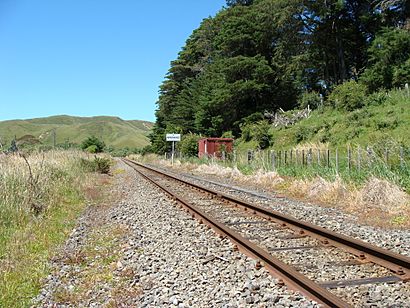Mangamahoe railway station facts for kids
Mangamahoe railway station was a train station that served the small community of Mangamahoe. This area is in the Wairarapa region of New Zealand’s North Island.
The station was on the Wairarapa Line. It was located between Mauriceville to the south and Eketahuna to the north. You could reach it from Station Road. Mangamahoe was the last station on the Wairarapa Line in the Greater Wellington Regional Council area. After this, the line went into the Horizons Regional Council region.
The station opened for all types of train traffic in 1887. It operated for about 82 years. It stopped handling general freight in 1966. Three years later, in 1969, it closed completely for passengers too.
The New Zealand Ministry for Culture and Heritage says that "Mangamāhoe" means "māhoe (whiteywood) stream".
Contents
What Was Mangamahoe Station Like?
Station Buildings and Features
Mangamahoe station had features typical of a small country railway station.
- Passenger Platform: By 1903, there was a wooden platform for people to get on and off trains.
- Station Building and Goods Shed: In 1905, a station building and a shed for goods were added.
- Loading Bank: A wooden loading bank was built in 1924. This was used for loading and unloading items.
- Staff Telephone: A telephone for staff was installed in 1929.
- Ways and Works Branch Shed: A shed for railway maintenance workers was built in 1962.
- Tablet Porter's Room: Inside the station building, there was a room for the "tablet porter." This person managed train movements.
- Toilets: Toilets were available for both staff and passengers.
Train Tracks and Yard
The station yard had several tracks. Besides the main line, there were also "crossing loops." These loops allowed trains to pass each other. There was also a siding for stockyards, used for loading farm animals.
In 1958, a request was made to remove the crossing loops. They were no longer needed. This was approved the next year. In June 1959, special safety devices called "trap points" were put in place. This meant the loop tracks were closed off. The loops were removed later when workers were available.
In 1962, changes were made to the yard. This was to allow larger Da class locomotives to use it. It was noted that all remaining tracks were still needed. However, the goods shed and the Way and Works Branch shed had verandas. These verandas were too low for the new Da locomotives. Since the verandas were not needed anymore, they were removed.
Station Staff
The station did not have many staff because it was small. A new caretaker was mentioned in 1905. The "tablet porter" was removed on April 7, 1929. After this, Mangamahoe became a "flag station." This meant trains would only stop if someone waved a flag or if passengers wanted to get off. Even without a porter, railway workers and train crews still used the station facilities.
How Trains Served Mangamahoe
Early Train Services
The first trains to serve Mangamahoe were "mixed" trains. These trains carried both passengers and freight. They ran from Wellington up the Wairarapa Line to Masterton. As the railway line extended further north, more communities were connected. This meant more farm products could be sent out by train.
Express Trains and Railcars
The Wairarapa Line was fully completed in 1897. This allowed the Railways Department to introduce the Napier Mail train. This express service had been running between Napier and Palmerston North. The Napier Mail was the first regular express passenger train on the Wairarapa Line. It served the Wairarapa until 1909.
After 1909, a new express passenger service started. It was called the Wairarapa Mail. This train ran between Wellington and Woodville.
In 1936, a new passenger service began with the Wairarapa railcars. These offered a faster and more comfortable journey for passengers from Mangamahoe. They could travel north to Woodville or south to Wellington. The Wairarapa Mail passenger trains continued, but their service was reduced in 1944. This was due to a serious coal shortage. The Wairarapa Mail was completely stopped in 1948.
A few years later, the Rimutaka Tunnel opened. This led to the end of the mixed trains and the Wairarapa-type railcars. After this, new twin-set railcars provided the only passenger service to Mangamahoe. These railcars continued until Mangamahoe closed to passengers in 1969. In 1959, the railcar timetable showed Mangamahoe as a "stops if required" station. This meant trains would only stop if passengers needed to get on or off.
Mangamahoe Station Today
Today, only a few things remain of the old Mangamahoe station. You can still see the platform and a small shelter shed. All the extra tracks and loops have been removed. The area where the yard used to be is now covered in tall grass. A sign for "Track Warrant Control" still marks the site as Mangamahoe.


